ECON6000 Module 3: Economic Principles and Decision Making Assessment
VerifiedAdded on 2023/01/16
|11
|1969
|67
Homework Assignment
AI Summary
This assignment analyzes economic principles and decision-making, focusing on a case study involving the introduction of the Schmeckt Besser energy bar. The student addresses questions related to demand elasticity (own price, income, and cross-price), market structure, and pricing strategies. The analysis includes calculations of price elasticity of demand using both point and midpoint methods, and cross-price elasticity. The assignment explores how Schmeckt Gut should approach market entry, considering factors like competitor analysis, product differentiation, and marketing strategies. Furthermore, the document examines the market structure (oligopoly or monopolistically competitive) and how it influences the company's approach to pricing and market share. References are provided to support the analysis.

Running head: ECONOMIC PRINCIPLES AND DECISION MAKING
Economic Principles and Decision Making
Name of the Student
Name of the University
Course ID
Economic Principles and Decision Making
Name of the Student
Name of the University
Course ID
Paraphrase This Document
Need a fresh take? Get an instant paraphrase of this document with our AI Paraphraser

1ECONOMIC PRINCIPLES AND DECISION MAKING
Table of Contents
Problem A........................................................................................................................................2
Question 1....................................................................................................................................2
Question 2....................................................................................................................................3
Problem B........................................................................................................................................4
Question 1....................................................................................................................................4
Question 2....................................................................................................................................5
Question 3....................................................................................................................................7
Question 4....................................................................................................................................7
Problem C........................................................................................................................................8
Question 1....................................................................................................................................8
Question 2....................................................................................................................................9
References......................................................................................................................................10
Table of Contents
Problem A........................................................................................................................................2
Question 1....................................................................................................................................2
Question 2....................................................................................................................................3
Problem B........................................................................................................................................4
Question 1....................................................................................................................................4
Question 2....................................................................................................................................5
Question 3....................................................................................................................................7
Question 4....................................................................................................................................7
Problem C........................................................................................................................................8
Question 1....................................................................................................................................8
Question 2....................................................................................................................................9
References......................................................................................................................................10
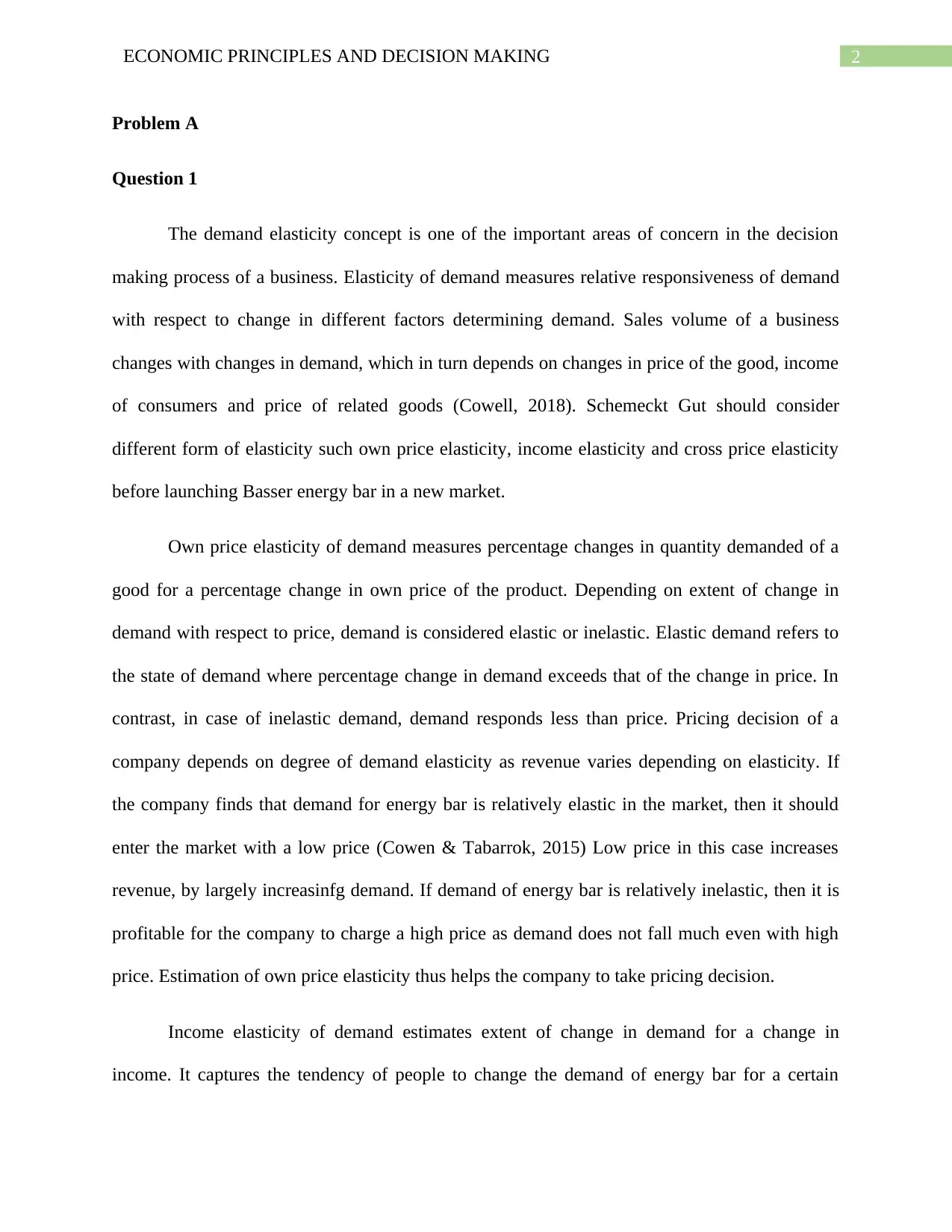
2ECONOMIC PRINCIPLES AND DECISION MAKING
Problem A
Question 1
The demand elasticity concept is one of the important areas of concern in the decision
making process of a business. Elasticity of demand measures relative responsiveness of demand
with respect to change in different factors determining demand. Sales volume of a business
changes with changes in demand, which in turn depends on changes in price of the good, income
of consumers and price of related goods (Cowell, 2018). Schemeckt Gut should consider
different form of elasticity such own price elasticity, income elasticity and cross price elasticity
before launching Basser energy bar in a new market.
Own price elasticity of demand measures percentage changes in quantity demanded of a
good for a percentage change in own price of the product. Depending on extent of change in
demand with respect to price, demand is considered elastic or inelastic. Elastic demand refers to
the state of demand where percentage change in demand exceeds that of the change in price. In
contrast, in case of inelastic demand, demand responds less than price. Pricing decision of a
company depends on degree of demand elasticity as revenue varies depending on elasticity. If
the company finds that demand for energy bar is relatively elastic in the market, then it should
enter the market with a low price (Cowen & Tabarrok, 2015) Low price in this case increases
revenue, by largely increasinfg demand. If demand of energy bar is relatively inelastic, then it is
profitable for the company to charge a high price as demand does not fall much even with high
price. Estimation of own price elasticity thus helps the company to take pricing decision.
Income elasticity of demand estimates extent of change in demand for a change in
income. It captures the tendency of people to change the demand of energy bar for a certain
Problem A
Question 1
The demand elasticity concept is one of the important areas of concern in the decision
making process of a business. Elasticity of demand measures relative responsiveness of demand
with respect to change in different factors determining demand. Sales volume of a business
changes with changes in demand, which in turn depends on changes in price of the good, income
of consumers and price of related goods (Cowell, 2018). Schemeckt Gut should consider
different form of elasticity such own price elasticity, income elasticity and cross price elasticity
before launching Basser energy bar in a new market.
Own price elasticity of demand measures percentage changes in quantity demanded of a
good for a percentage change in own price of the product. Depending on extent of change in
demand with respect to price, demand is considered elastic or inelastic. Elastic demand refers to
the state of demand where percentage change in demand exceeds that of the change in price. In
contrast, in case of inelastic demand, demand responds less than price. Pricing decision of a
company depends on degree of demand elasticity as revenue varies depending on elasticity. If
the company finds that demand for energy bar is relatively elastic in the market, then it should
enter the market with a low price (Cowen & Tabarrok, 2015) Low price in this case increases
revenue, by largely increasinfg demand. If demand of energy bar is relatively inelastic, then it is
profitable for the company to charge a high price as demand does not fall much even with high
price. Estimation of own price elasticity thus helps the company to take pricing decision.
Income elasticity of demand estimates extent of change in demand for a change in
income. It captures the tendency of people to change the demand of energy bar for a certain
⊘ This is a preview!⊘
Do you want full access?
Subscribe today to unlock all pages.

Trusted by 1+ million students worldwide
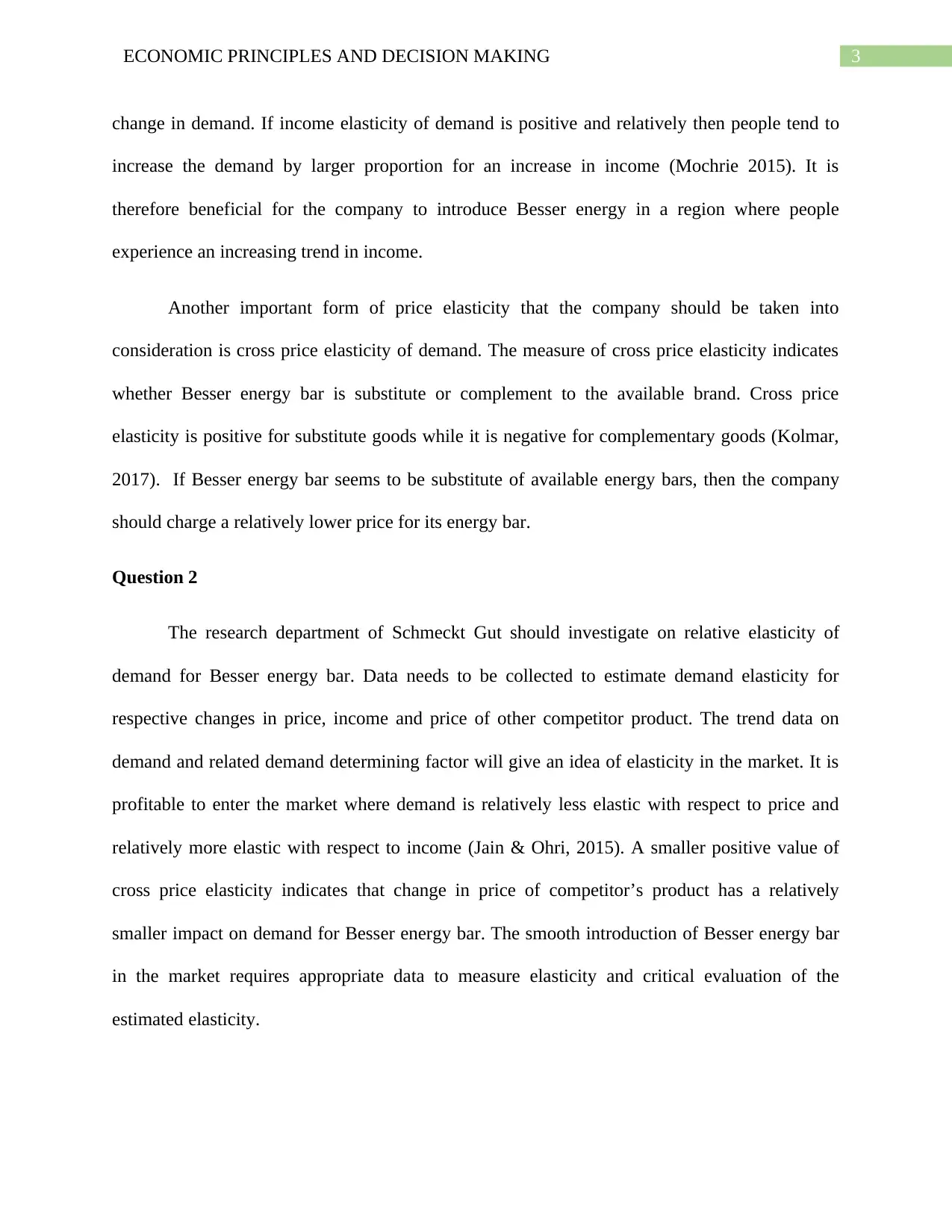
3ECONOMIC PRINCIPLES AND DECISION MAKING
change in demand. If income elasticity of demand is positive and relatively then people tend to
increase the demand by larger proportion for an increase in income (Mochrie 2015). It is
therefore beneficial for the company to introduce Besser energy in a region where people
experience an increasing trend in income.
Another important form of price elasticity that the company should be taken into
consideration is cross price elasticity of demand. The measure of cross price elasticity indicates
whether Besser energy bar is substitute or complement to the available brand. Cross price
elasticity is positive for substitute goods while it is negative for complementary goods (Kolmar,
2017). If Besser energy bar seems to be substitute of available energy bars, then the company
should charge a relatively lower price for its energy bar.
Question 2
The research department of Schmeckt Gut should investigate on relative elasticity of
demand for Besser energy bar. Data needs to be collected to estimate demand elasticity for
respective changes in price, income and price of other competitor product. The trend data on
demand and related demand determining factor will give an idea of elasticity in the market. It is
profitable to enter the market where demand is relatively less elastic with respect to price and
relatively more elastic with respect to income (Jain & Ohri, 2015). A smaller positive value of
cross price elasticity indicates that change in price of competitor’s product has a relatively
smaller impact on demand for Besser energy bar. The smooth introduction of Besser energy bar
in the market requires appropriate data to measure elasticity and critical evaluation of the
estimated elasticity.
change in demand. If income elasticity of demand is positive and relatively then people tend to
increase the demand by larger proportion for an increase in income (Mochrie 2015). It is
therefore beneficial for the company to introduce Besser energy in a region where people
experience an increasing trend in income.
Another important form of price elasticity that the company should be taken into
consideration is cross price elasticity of demand. The measure of cross price elasticity indicates
whether Besser energy bar is substitute or complement to the available brand. Cross price
elasticity is positive for substitute goods while it is negative for complementary goods (Kolmar,
2017). If Besser energy bar seems to be substitute of available energy bars, then the company
should charge a relatively lower price for its energy bar.
Question 2
The research department of Schmeckt Gut should investigate on relative elasticity of
demand for Besser energy bar. Data needs to be collected to estimate demand elasticity for
respective changes in price, income and price of other competitor product. The trend data on
demand and related demand determining factor will give an idea of elasticity in the market. It is
profitable to enter the market where demand is relatively less elastic with respect to price and
relatively more elastic with respect to income (Jain & Ohri, 2015). A smaller positive value of
cross price elasticity indicates that change in price of competitor’s product has a relatively
smaller impact on demand for Besser energy bar. The smooth introduction of Besser energy bar
in the market requires appropriate data to measure elasticity and critical evaluation of the
estimated elasticity.
Paraphrase This Document
Need a fresh take? Get an instant paraphrase of this document with our AI Paraphraser
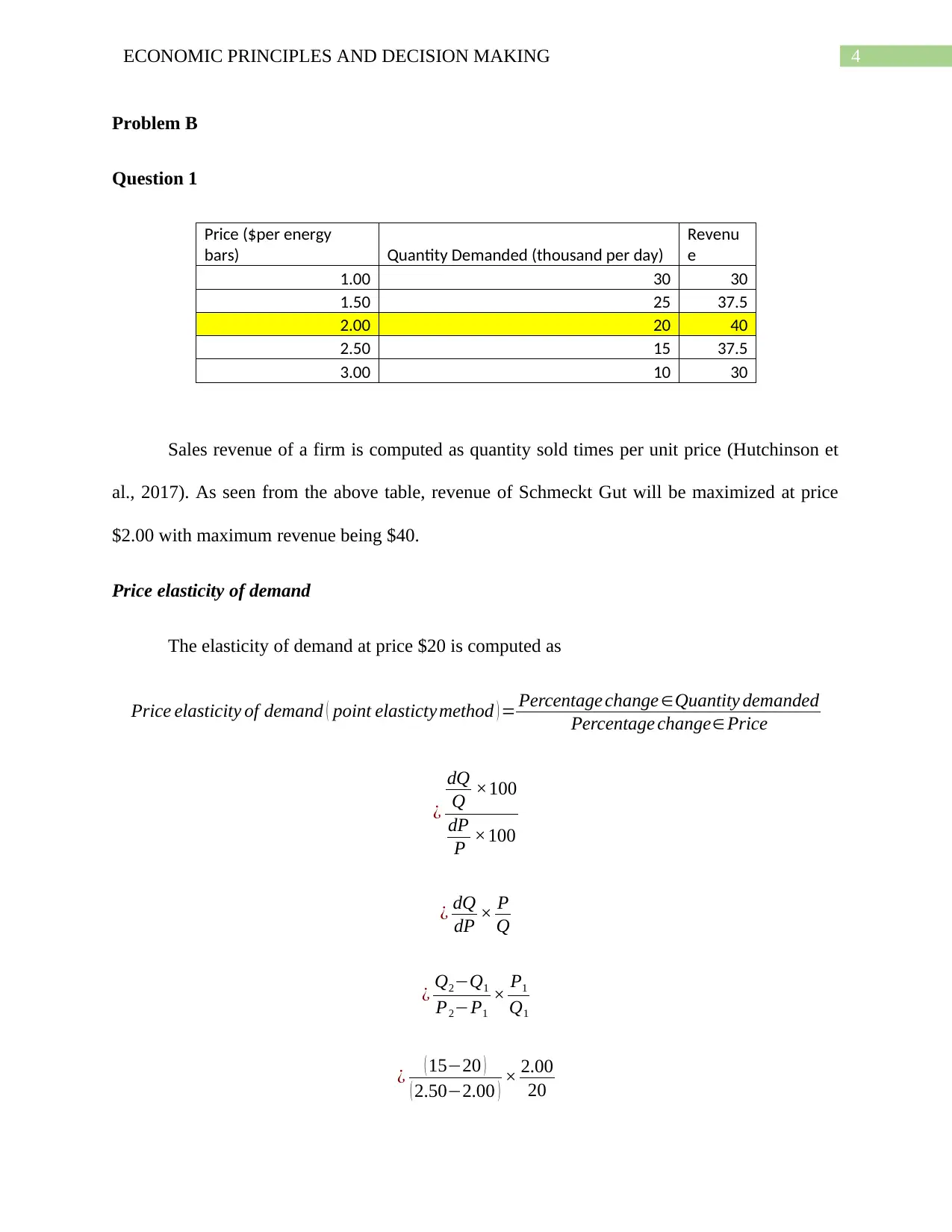
4ECONOMIC PRINCIPLES AND DECISION MAKING
Problem B
Question 1
Price ($per energy
bars) Quantity Demanded (thousand per day)
Revenu
e
1.00 30 30
1.50 25 37.5
2.00 20 40
2.50 15 37.5
3.00 10 30
Sales revenue of a firm is computed as quantity sold times per unit price (Hutchinson et
al., 2017). As seen from the above table, revenue of Schmeckt Gut will be maximized at price
$2.00 with maximum revenue being $40.
Price elasticity of demand
The elasticity of demand at price $20 is computed as
Price elasticity of demand ( point elasticty method ) = Percentage change ∈Quantity demanded
Percentage change∈Price
¿
dQ
Q ×100
dP
P ×100
¿ dQ
dP × P
Q
¿ Q2−Q1
P2−P1
× P1
Q1
¿ ( 15−20 )
( 2.50−2.00 ) × 2.00
20
Problem B
Question 1
Price ($per energy
bars) Quantity Demanded (thousand per day)
Revenu
e
1.00 30 30
1.50 25 37.5
2.00 20 40
2.50 15 37.5
3.00 10 30
Sales revenue of a firm is computed as quantity sold times per unit price (Hutchinson et
al., 2017). As seen from the above table, revenue of Schmeckt Gut will be maximized at price
$2.00 with maximum revenue being $40.
Price elasticity of demand
The elasticity of demand at price $20 is computed as
Price elasticity of demand ( point elasticty method ) = Percentage change ∈Quantity demanded
Percentage change∈Price
¿
dQ
Q ×100
dP
P ×100
¿ dQ
dP × P
Q
¿ Q2−Q1
P2−P1
× P1
Q1
¿ ( 15−20 )
( 2.50−2.00 ) × 2.00
20
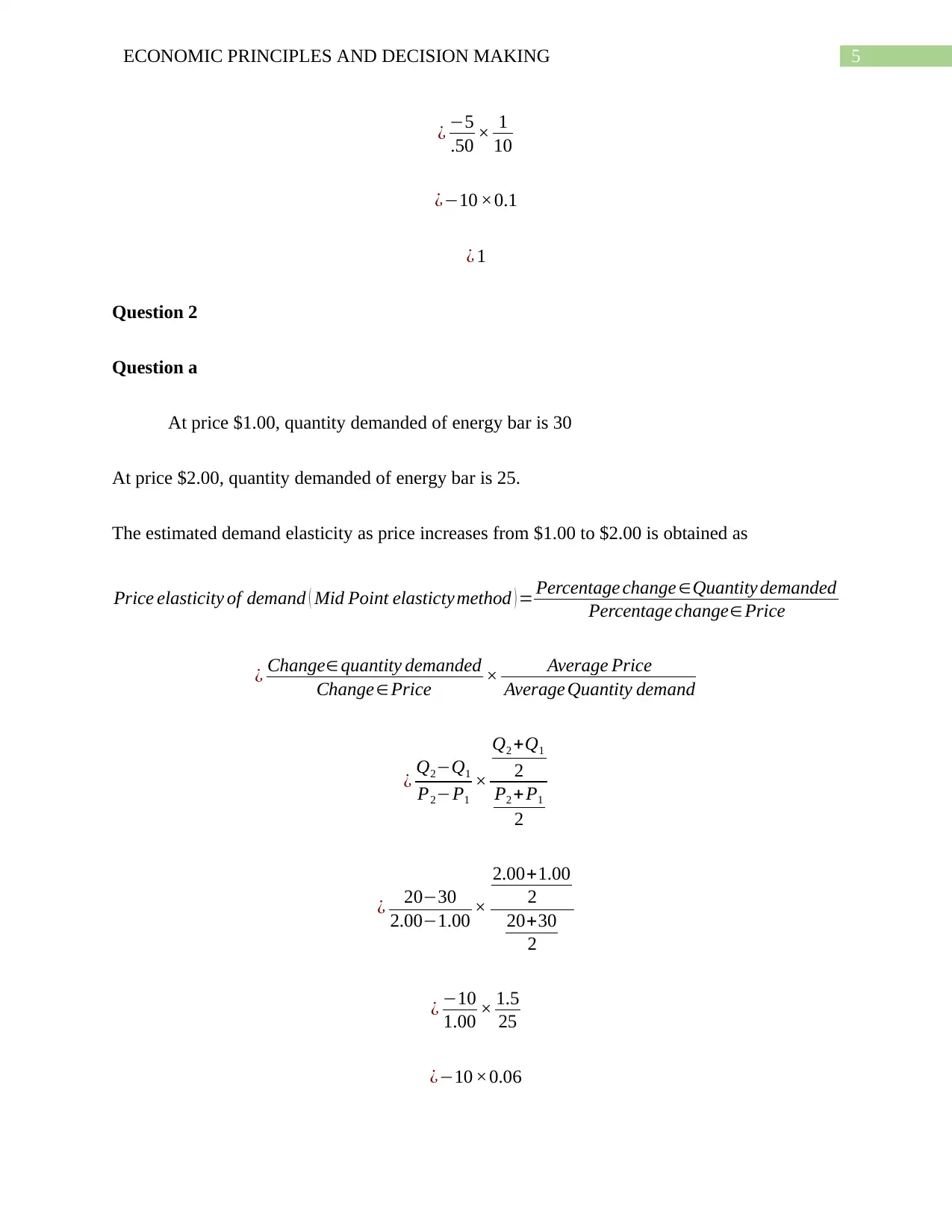
5ECONOMIC PRINCIPLES AND DECISION MAKING
¿ −5
.50 × 1
10
¿−10 ×0.1
¿ 1
Question 2
Question a
At price $1.00, quantity demanded of energy bar is 30
At price $2.00, quantity demanded of energy bar is 25.
The estimated demand elasticity as price increases from $1.00 to $2.00 is obtained as
Price elasticity of demand ( Mid Point elasticty method ) = Percentage change ∈Quantity demanded
Percentage change∈ Price
¿ Change∈quantity demanded
Change∈ Price × Average Price
Average Quantity demand
¿ Q2−Q1
P2−P1
×
Q2 +Q1
2
P2 +P1
2
¿ 20−30
2.00−1.00 ×
2.00+1.00
2
20+30
2
¿ −10
1.00 × 1.5
25
¿−10 ×0.06
¿ −5
.50 × 1
10
¿−10 ×0.1
¿ 1
Question 2
Question a
At price $1.00, quantity demanded of energy bar is 30
At price $2.00, quantity demanded of energy bar is 25.
The estimated demand elasticity as price increases from $1.00 to $2.00 is obtained as
Price elasticity of demand ( Mid Point elasticty method ) = Percentage change ∈Quantity demanded
Percentage change∈ Price
¿ Change∈quantity demanded
Change∈ Price × Average Price
Average Quantity demand
¿ Q2−Q1
P2−P1
×
Q2 +Q1
2
P2 +P1
2
¿ 20−30
2.00−1.00 ×
2.00+1.00
2
20+30
2
¿ −10
1.00 × 1.5
25
¿−10 ×0.06
⊘ This is a preview!⊘
Do you want full access?
Subscribe today to unlock all pages.

Trusted by 1+ million students worldwide
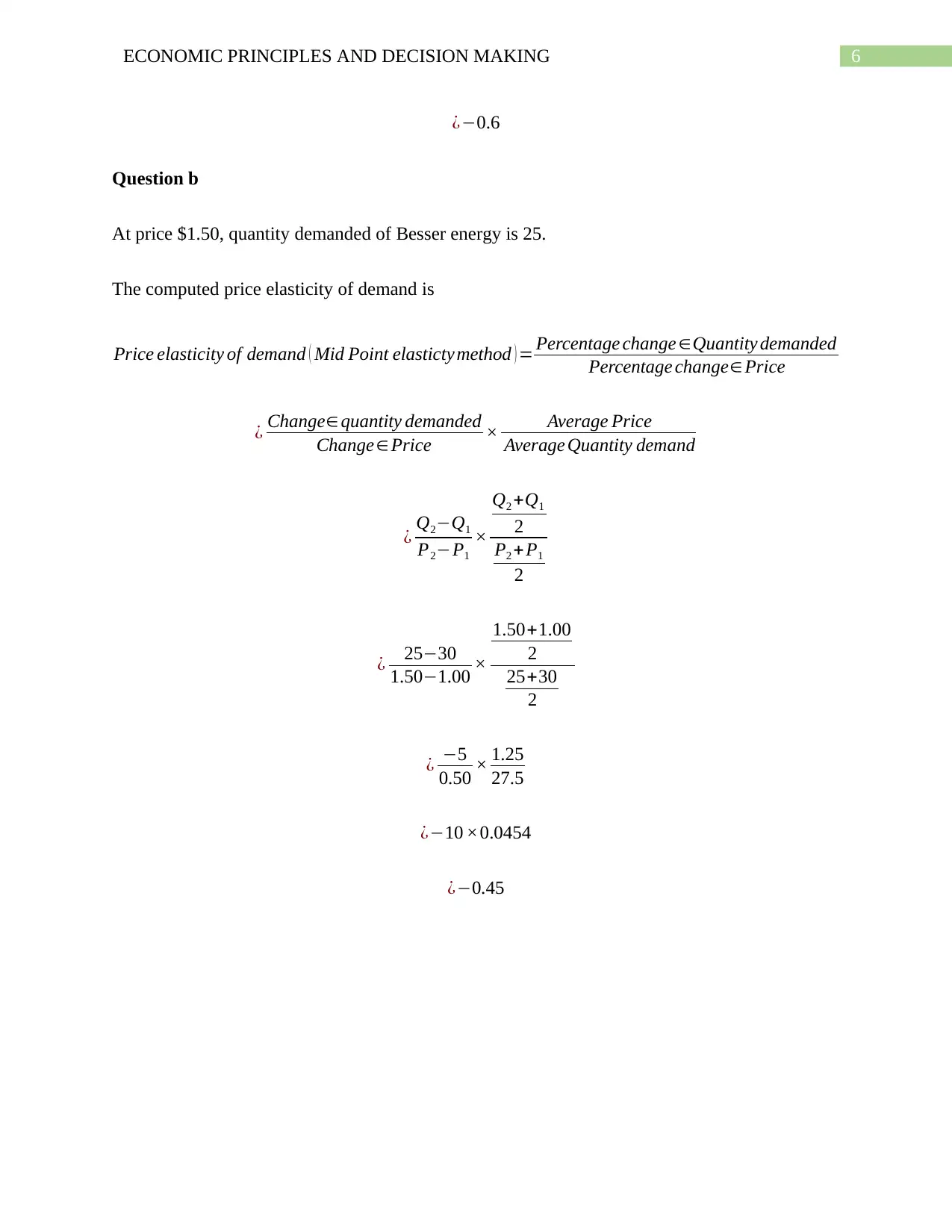
6ECONOMIC PRINCIPLES AND DECISION MAKING
¿−0.6
Question b
At price $1.50, quantity demanded of Besser energy is 25.
The computed price elasticity of demand is
Price elasticity of demand ( Mid Point elasticty method ) = Percentage change ∈Quantity demanded
Percentage change∈ Price
¿ Change∈quantity demanded
Change∈ Price × Average Price
Average Quantity demand
¿ Q2−Q1
P2−P1
×
Q2 +Q1
2
P2 +P1
2
¿ 25−30
1.50−1.00 ×
1.50+1.00
2
25+30
2
¿ −5
0.50 × 1.25
27.5
¿−10 ×0.0454
¿−0.45
¿−0.6
Question b
At price $1.50, quantity demanded of Besser energy is 25.
The computed price elasticity of demand is
Price elasticity of demand ( Mid Point elasticty method ) = Percentage change ∈Quantity demanded
Percentage change∈ Price
¿ Change∈quantity demanded
Change∈ Price × Average Price
Average Quantity demand
¿ Q2−Q1
P2−P1
×
Q2 +Q1
2
P2 +P1
2
¿ 25−30
1.50−1.00 ×
1.50+1.00
2
25+30
2
¿ −5
0.50 × 1.25
27.5
¿−10 ×0.0454
¿−0.45
Paraphrase This Document
Need a fresh take? Get an instant paraphrase of this document with our AI Paraphraser

7ECONOMIC PRINCIPLES AND DECISION MAKING
Question 3
Question a
With decrease in price of Schmeckt Gut energy bar from $3.00 to $2.00 lower the
quantity demanded of Fly High’s energy bar from 11 to 9. The cross price elasticity of demand
between Schemeckt Gut’s energy bar and that of Fly High’s energy bar is obtained as
ross Price elasticity of demand ( Mid Point elasticty method ) = Percentage change∈Quantity demanded (QX )
Percentage change∈ Price( PY )
¿ Change∈quantity demanded
Change∈ Price × Average Price
Average Quantity demand
¿ QX 2−QX 1
PY 2−PY 1
×
PY 2+PY 1
2
QX 2+QX 1
2
¿ 9−11
2.00−3.00 ×
2.00+3.00
2
9+11
2
¿ −2
1.00 × 2.5
10
¿−2× 0.25
¿ 0.5
Question 4
As revealed from the above information, decreases in price of Schmeckt Gut energy bar
increases the demand for Schmeckt Gut’s energy bar. The lower price of Schmeckt Gut’s energy
Question 3
Question a
With decrease in price of Schmeckt Gut energy bar from $3.00 to $2.00 lower the
quantity demanded of Fly High’s energy bar from 11 to 9. The cross price elasticity of demand
between Schemeckt Gut’s energy bar and that of Fly High’s energy bar is obtained as
ross Price elasticity of demand ( Mid Point elasticty method ) = Percentage change∈Quantity demanded (QX )
Percentage change∈ Price( PY )
¿ Change∈quantity demanded
Change∈ Price × Average Price
Average Quantity demand
¿ QX 2−QX 1
PY 2−PY 1
×
PY 2+PY 1
2
QX 2+QX 1
2
¿ 9−11
2.00−3.00 ×
2.00+3.00
2
9+11
2
¿ −2
1.00 × 2.5
10
¿−2× 0.25
¿ 0.5
Question 4
As revealed from the above information, decreases in price of Schmeckt Gut energy bar
increases the demand for Schmeckt Gut’s energy bar. The lower price of Schmeckt Gut’s energy
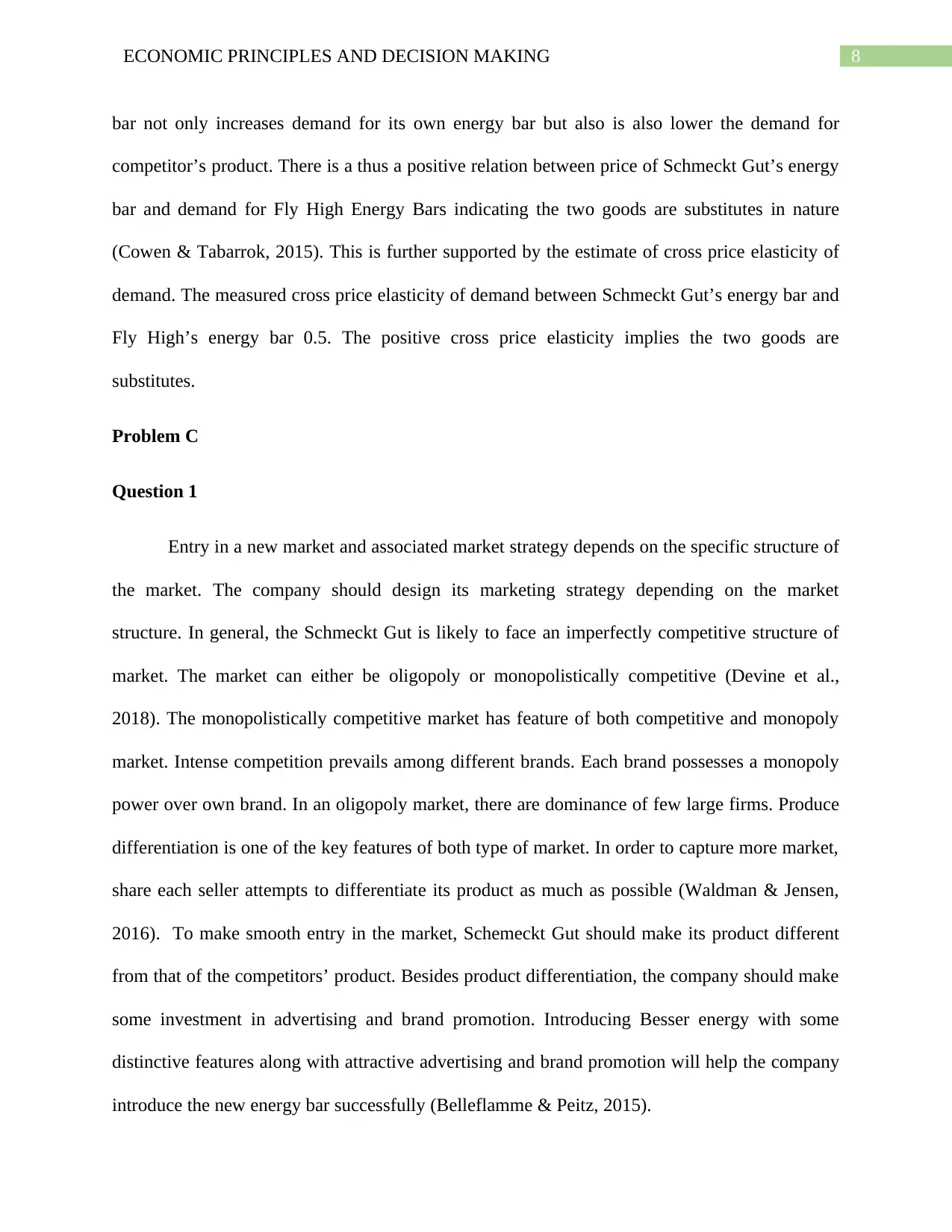
8ECONOMIC PRINCIPLES AND DECISION MAKING
bar not only increases demand for its own energy bar but also is also lower the demand for
competitor’s product. There is a thus a positive relation between price of Schmeckt Gut’s energy
bar and demand for Fly High Energy Bars indicating the two goods are substitutes in nature
(Cowen & Tabarrok, 2015). This is further supported by the estimate of cross price elasticity of
demand. The measured cross price elasticity of demand between Schmeckt Gut’s energy bar and
Fly High’s energy bar 0.5. The positive cross price elasticity implies the two goods are
substitutes.
Problem C
Question 1
Entry in a new market and associated market strategy depends on the specific structure of
the market. The company should design its marketing strategy depending on the market
structure. In general, the Schmeckt Gut is likely to face an imperfectly competitive structure of
market. The market can either be oligopoly or monopolistically competitive (Devine et al.,
2018). The monopolistically competitive market has feature of both competitive and monopoly
market. Intense competition prevails among different brands. Each brand possesses a monopoly
power over own brand. In an oligopoly market, there are dominance of few large firms. Produce
differentiation is one of the key features of both type of market. In order to capture more market,
share each seller attempts to differentiate its product as much as possible (Waldman & Jensen,
2016). To make smooth entry in the market, Schemeckt Gut should make its product different
from that of the competitors’ product. Besides product differentiation, the company should make
some investment in advertising and brand promotion. Introducing Besser energy with some
distinctive features along with attractive advertising and brand promotion will help the company
introduce the new energy bar successfully (Belleflamme & Peitz, 2015).
bar not only increases demand for its own energy bar but also is also lower the demand for
competitor’s product. There is a thus a positive relation between price of Schmeckt Gut’s energy
bar and demand for Fly High Energy Bars indicating the two goods are substitutes in nature
(Cowen & Tabarrok, 2015). This is further supported by the estimate of cross price elasticity of
demand. The measured cross price elasticity of demand between Schmeckt Gut’s energy bar and
Fly High’s energy bar 0.5. The positive cross price elasticity implies the two goods are
substitutes.
Problem C
Question 1
Entry in a new market and associated market strategy depends on the specific structure of
the market. The company should design its marketing strategy depending on the market
structure. In general, the Schmeckt Gut is likely to face an imperfectly competitive structure of
market. The market can either be oligopoly or monopolistically competitive (Devine et al.,
2018). The monopolistically competitive market has feature of both competitive and monopoly
market. Intense competition prevails among different brands. Each brand possesses a monopoly
power over own brand. In an oligopoly market, there are dominance of few large firms. Produce
differentiation is one of the key features of both type of market. In order to capture more market,
share each seller attempts to differentiate its product as much as possible (Waldman & Jensen,
2016). To make smooth entry in the market, Schemeckt Gut should make its product different
from that of the competitors’ product. Besides product differentiation, the company should make
some investment in advertising and brand promotion. Introducing Besser energy with some
distinctive features along with attractive advertising and brand promotion will help the company
introduce the new energy bar successfully (Belleflamme & Peitz, 2015).
⊘ This is a preview!⊘
Do you want full access?
Subscribe today to unlock all pages.

Trusted by 1+ million students worldwide
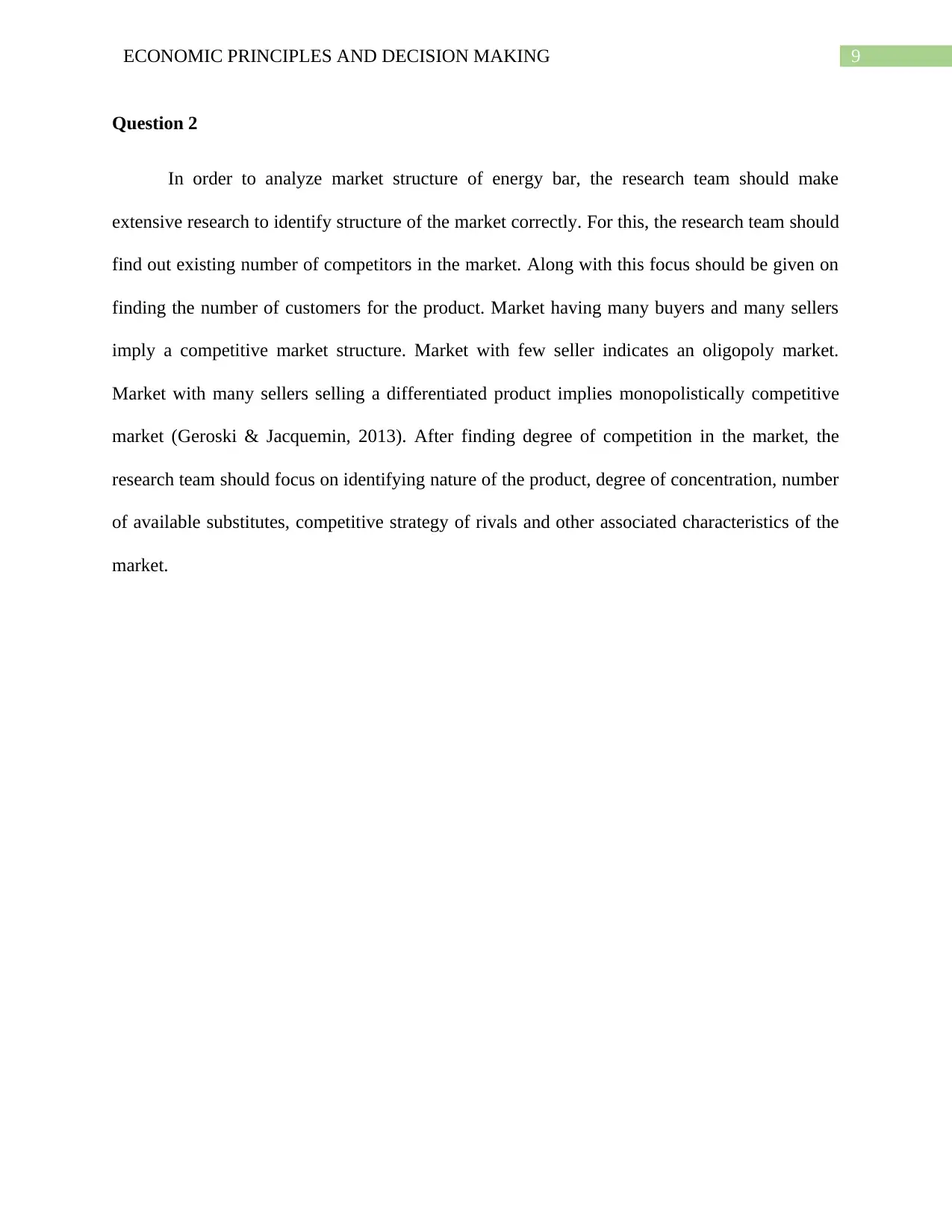
9ECONOMIC PRINCIPLES AND DECISION MAKING
Question 2
In order to analyze market structure of energy bar, the research team should make
extensive research to identify structure of the market correctly. For this, the research team should
find out existing number of competitors in the market. Along with this focus should be given on
finding the number of customers for the product. Market having many buyers and many sellers
imply a competitive market structure. Market with few seller indicates an oligopoly market.
Market with many sellers selling a differentiated product implies monopolistically competitive
market (Geroski & Jacquemin, 2013). After finding degree of competition in the market, the
research team should focus on identifying nature of the product, degree of concentration, number
of available substitutes, competitive strategy of rivals and other associated characteristics of the
market.
Question 2
In order to analyze market structure of energy bar, the research team should make
extensive research to identify structure of the market correctly. For this, the research team should
find out existing number of competitors in the market. Along with this focus should be given on
finding the number of customers for the product. Market having many buyers and many sellers
imply a competitive market structure. Market with few seller indicates an oligopoly market.
Market with many sellers selling a differentiated product implies monopolistically competitive
market (Geroski & Jacquemin, 2013). After finding degree of competition in the market, the
research team should focus on identifying nature of the product, degree of concentration, number
of available substitutes, competitive strategy of rivals and other associated characteristics of the
market.
Paraphrase This Document
Need a fresh take? Get an instant paraphrase of this document with our AI Paraphraser

10ECONOMIC PRINCIPLES AND DECISION MAKING
References
Belleflamme, P., & Peitz, M. (2015). Industrial organization: markets and strategies. Cambridge
University Press.
Cowell, F. (2018). Microeconomics: principles and analysis. Oxford University Press.
Cowen, T., & Tabarrok, A. (2015). Modern principles of microeconomics. Macmillan
International Higher Education.
Devine, P. J., Lee, N., Jones, R. M., & Tyson, W. J. (2018). An introduction to industrial
economics. Routledge.
Geroski, P. G., & Jacquemin, A. (2013). Barriers to entry and strategic competition. Routledge.
Hutchinson, E., Nicholson, M., Lukenchuk, B., & Taylor, T. (2017). Principles of
Microeconomics. University of Victoria.
Jain, T. R., & Ohri, V. K. (2015). Principal of Microeconomics. FK Publications.
Kolmar, M. (2017). Principles of Microeconomics. Springer International Publishing.
Mochrie, R. (2015). Intermediate microeconomics. Macmillan International Higher Education.
Waldman, D., & Jensen, E. (2016). Industrial organization: theory and practice. Routledge.
References
Belleflamme, P., & Peitz, M. (2015). Industrial organization: markets and strategies. Cambridge
University Press.
Cowell, F. (2018). Microeconomics: principles and analysis. Oxford University Press.
Cowen, T., & Tabarrok, A. (2015). Modern principles of microeconomics. Macmillan
International Higher Education.
Devine, P. J., Lee, N., Jones, R. M., & Tyson, W. J. (2018). An introduction to industrial
economics. Routledge.
Geroski, P. G., & Jacquemin, A. (2013). Barriers to entry and strategic competition. Routledge.
Hutchinson, E., Nicholson, M., Lukenchuk, B., & Taylor, T. (2017). Principles of
Microeconomics. University of Victoria.
Jain, T. R., & Ohri, V. K. (2015). Principal of Microeconomics. FK Publications.
Kolmar, M. (2017). Principles of Microeconomics. Springer International Publishing.
Mochrie, R. (2015). Intermediate microeconomics. Macmillan International Higher Education.
Waldman, D., & Jensen, E. (2016). Industrial organization: theory and practice. Routledge.
1 out of 11
Related Documents
Your All-in-One AI-Powered Toolkit for Academic Success.
+13062052269
info@desklib.com
Available 24*7 on WhatsApp / Email
![[object Object]](/_next/static/media/star-bottom.7253800d.svg)
Unlock your academic potential
Copyright © 2020–2025 A2Z Services. All Rights Reserved. Developed and managed by ZUCOL.




